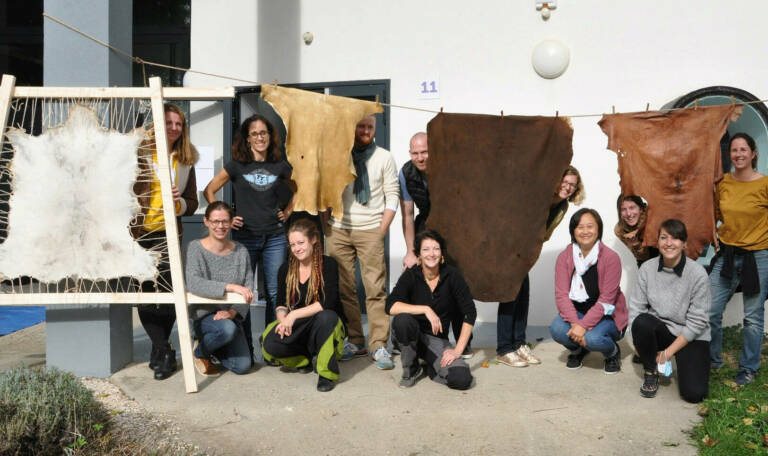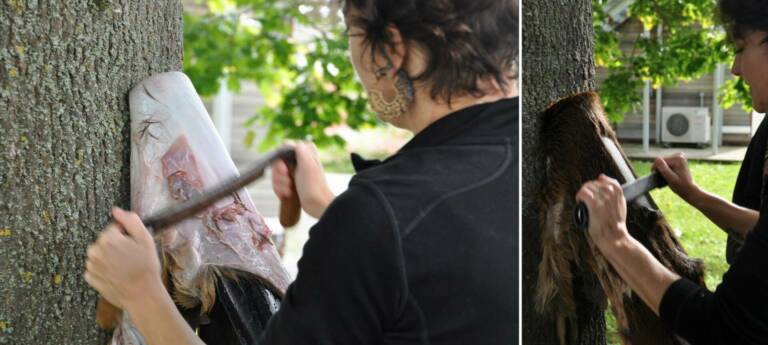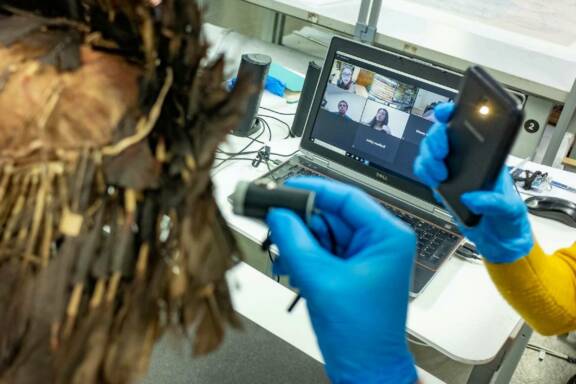The Workshop "Tanning Hides": the Vital Role of Experimental Archaeology for Understanding Ancient Objects
Identifying the tanning process used on a hide held in a museum is no easy task, unless you are - like Theresa Emmerich Kamper, who holds a doctorate in experimental archaeology from the University of Exeter - a specialist in the field. In October 2021, Dr Emmerich Kamper, assisted by Sabine Martin, a doctoral student in archaeology (University of Exeter), led a hide-tanning workshop attended by several CRoyAN project partners. By the end of the four-day workshop, with its equal emphasis on theoretical and practical instruction, participants were able to identify different tanning processes and the concrete steps involved in each, whereby an animal skin is transformed from a material subject to putrefaction to one that will not rot.

Getting to grips with brain matter
What better way to understand a manufacturing technique than to practice it oneself! And not one, but three methods were demonstrated during the workshop: rawhides, vegetable tanned hides, and fat (brain) tanned hides. As each of these processes can take from a few weeks to several months, Theresa Emmerich Kamper had brought along with her in her van several deer- and buckskins, at different stages of the tanning process, so that we could practice each stage.
The first stage, common to all the methods, is defleshing and dehairing, during which the remaining flesh on one side of the skin and the hair on the other side are removed mechanically with a blunt metal knife (earlier, bone was used). The ensuing steps then diverge, depending on the properties sought and the use to which the hide will be put.

The rawhide was simply stretched over a frame to dry it, and, depending on the desired finish, it could be rubbed with a pumice stone and/or chalk. The result obtained is a light-colored, flat and rigid material like parchment, light in weight, but also very reactive to water.
For vegetable tanning, after removing the flesh and hair, the skin is immersed in a water bath rich in vegetable tannins. In the past, plant parts such as tree bark and leaves were used, and the tanning process could take between 12 and 18 months to complete, that is, to penetrate deep into the hide. Nowadays – as was exemplified in this workshop – tannin extracts are used, that is, only the active tanning compounds, which reduces the length of time for this crucial stage to one month. The hide is then partially dried, and then oiled with vegetable or animal fats, using mechanical action to make it soft again. The result is a relatively hard and thick brown leather that retains its grain (the hair follicle holes) and is quite water-resistant.

2) Vegetable tanned deerhide, oiled with vegetable fat, and worked to make it soft again
© Laurianne Robinet
For tanning with animal fats, Dr Emmerich Kamper stressed the importance of removing the top layer of skin during the initial dehairing stage so that the hide will be able to fully absorb the fat. The hide is then worked on in a bath of brains emulsified with water, which makes it smooth and silky. The ensuing stages require a lot of physical effort, first to remove the water by wringing out the hide and using the blunt knife, then to soften it by stretching it out and rubbing it energetically over a cable or the edge of a piece of wood. The result is an incredibly soft and elastic white skin that can be used to make clothes, among other things.

In order to improve the hide's stability over time and its resistance to water, it can be smoked, which gives it a yellow-grey colour, and a quite distinctive smell. Dr Emmerich Kamper illustrated this by making a sort of bag with the hide, and placing it on the stovepipe of a small wood-burning stove, exposing each side of the bag to the smoke for half an hour. For the last stage, depending on the desired finish, the hide may be dyed, as was done using a walnut stain solution to give the material a deep brown colour.

© Laurianne Robinet
Zoom on the binocular loupe
As we have seen, working the hide leaves marks, some of which can be seen with the naked eye, while others are only visible under binocular magnifying glasses. Theresa Emmerich Kamper has categorised these marks by applying different macroscopic and microscopic criteria, which indicate the processes used. Amongst the most conclusive macroscopic criteria are the colour of the hide (a dark hide has almost certainly had vegetable tanning), its elasticity (a supple and elastic hide will have been fat tanned), the surface texture (presence or absence of grain), and the thickness (the edge is a clue to the degree of penetration of the tanning agents). Microscopic criteria concern the fibrous tissue: its compactness (depending on how densely the tanning agent coats the fibres), its orientation (the direction in which the hide has been stretched, and the point in the process at which the stretching took place); and how the fibres look (contoured, glossy, translucent, etc). Tool marks can also be revealing, as the skin can be fleshed dry or wet, leaving more or less visible indentations.

By applying her criteria to all these marks, Theresa Emmerich Kamper is able to identify the method used to tan a hide. However, the situation is more complex with finely-worked or antique objects such as a bag, a coat or moccasins. It is not always possible to examine the reverse side of the hide if the object has been lined, for example, or if there is fur. Surface treatments such as painting or dyeing can also hinder the identification of the tanning method. Additionally, as most of the hide objects are everyday items, their history may compromise visual analysis: they have been worn and used, as well as undergoing changes since their arrival in museum collections due to their conditions of conservation. The state of the hide is therefore an important factor in identifying the tanning method used. Theresa Emmerich Kamper takes this into account in having clothes made out of some of her tanned hides, and wearing them frequently in order to study the impact of natural wear.
By the end of these four memorable days, we had gained a detailed appreciation of each tanning process, and the particular properties each confers on the skins. We were able to take away reference samples from each stage of the tanning process, in order to develop laboratory analysis techniques to help us characterize the older methods used to make the tanned hides in the heritage collections.

Contributors
Resources
Emmerich Kamper, Theresa, Determining Prehistoric Skin Processing Technologies The Macro and Microscopic Characteristics of Experimental Samples. Sidestone Press, 2020.
Related Topics









